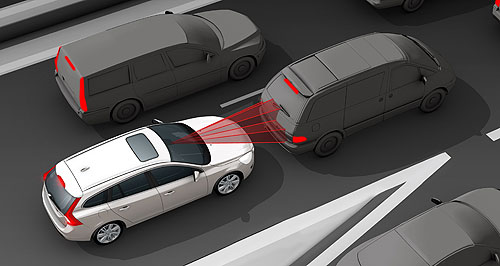News - General News - SafetyDoctors join push for autonomous brakingPoint brake: ANCAP chief executive officer Nicholas Clarke (left) and AMA president Brian Owler join forces in Canberra to promote the benefits of safety tech such as of autonomous emergency braking. ANCAP and AMA encourage government and road users to press for autonomous braking12 Aug 2015 THE Australian New Car Assessment Program (ANCAP) has teamed with the Australian Medical Association (AMA) to push governments and car-makers to include potentially life-saving safety gear, such as autonomous emergency braking (AEB) on all new cars sold Down Under. ANCAP has been urging car-makers to adopt the technology more widely for some time, while encouraging consumers to consider purchasing a new vehicle only if it is fitted, but the inclusion of the AMA in its push is likely to give the campaign more weight. AEB uses cameras and sensors to monitor the distance of vehicles in front, detecting when a collision is imminent and applying the brakes without the intervention of the driver when required. AMA president Brian Owler launched the 'Avoid the Crash, Avoid the Trauma' campaign at Parliament House in Canberra this week. Professor Owler is also a leading neurosurgeon based in Sydney and the public face of the New South Wales government's 'Don't Rush' road safety campaign. Professor Owler used the launch to encourage governments, car-makers and road users to push for the safety, and said that road trauma was avoidable. “The key is making cars safer, and educating drivers about the risks of speeding and careless driving,” he said. “Too often, I see the horrific injuries and loss of life caused by road crashes when drivers get it wrong. “Prevention is far better than the cure – if we avoid the crash, we avoid the trauma.” Professor Owler highlighted the impact road trauma has on society, and suggested that cost should not be a barrier for life-saving safety equipment. “Road safety and public health go hand in hand,” he said. “Road trauma has an enormous impact on the lives of everyday Australians and our health system. “We must do all we can to eliminate it, and governments have an important role to play, especially in working with the car industry to make cars safer, preferably by making life-saving technology like AEB standard features in all new cars. “The safest cars should be in reach of all Australian drivers. “Vehicle technologies such as AEB can help reduce road trauma at a much faster rate than we are seeing now.” In a joint statement with the AMA, ANCAP chief executive officer Nicholas Clarke said while the road toll is dropping each year, further deaths would be preventable if car-makers offered the autonomous braking tech standard on more models. “AEB is a technology that will reduce the number of deaths and injuries from road crashes,” he said. “While the number of people killed on Australia's roads is declining, road crashes are still unnecessarily killing around 1200 people every year. Technology like AEB will go a long way towards reducing the number of fatalities.” Meanwhile, in the lead up to the Senate Road Safety Inquiry public hearings in Canberra last week, Federal Chamber of Automotive Industries (FCAI) chief executive Tony Weber highlighted how new technology had helped improve the national road toll. Mr Weber said car-makers were making big gains in safety tech, but called for greater collaboration between industry and governments to ensure adequate support for the roll out of connected technology. “We have one of the most competitive new-car markets in the world,” he said. “This competition is good for road safety, with manufacturers continually striving to introduce the very latest technologies into their vehicles. “In particular, the development of connected cars has the potential to significantly improve road safety in Australia and reduce congestion on our roads to make the daily commute a safer and easier experience. “To effectively introduce more connected vehicles into Australia, it is vital that governments and industry work together to ensure that the infrastructure and systems that support the vehicles are set up and maintained.” Mr Weber cited data from IHS Automotive that shows rates of new models fitted with AEB is similar to that of Europe, with 29 per cent of new passenger cars now featuring the tech – a rise from 14 per cent in 2014 – while 19 per cent of new SUVs are fitted with AEB, up from 11 per cent last year. “These systems are available in many new vehicles today,” he said. “AEB is known to show a significant reduction in low-speed rear-end crashes around the world and manufacturers selling vehicles in Australia are increasingly fitting this and other safety technology into the models they are bringing to the Australian market.”  Read more7th of July 2015  More top ANCAP scoresJeep Grand Cherokee, Holden Astra and Skoda Fabia score five ANCAP stars8th of June 2015  Skoda Fabia to kick off with autonomous brakingAutonomous emergency braking to be standard on forthcoming third-gen Skoda Fabia15th of April 2015  Demand auto braking now, says ANCAPFleet managers urged to push hard for latest anti-crash technology |
Click to shareGeneral News articlesResearch General News Motor industry news |
















Facebook Twitter Instagram